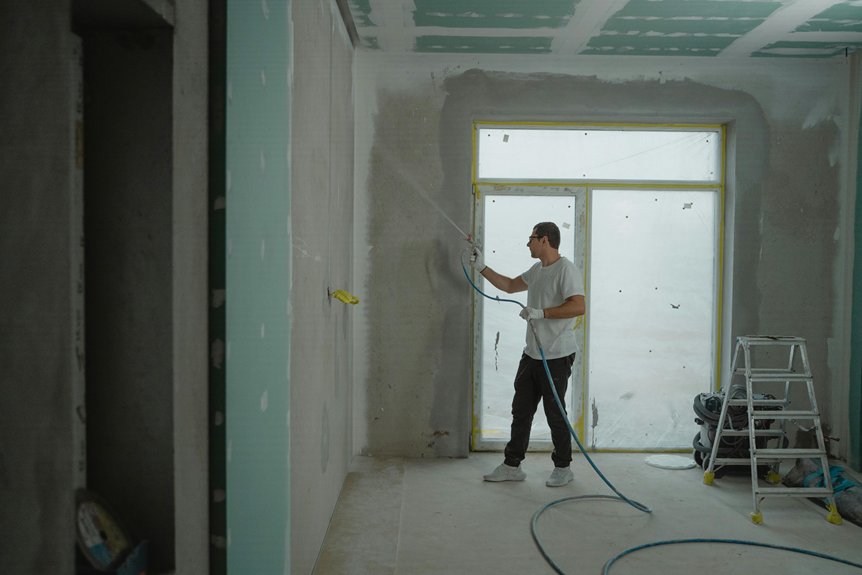Maintaining your home each year is vital for preserving its value and ensuring safety. You’ll want to start by inspecting the exterior for any signs of wear and tear, then move on to essential systems like your roof, gutters, and HVAC. These proactive steps not only enhance efficiency but also prevent costly repairs down the line. As you tackle these tasks, there are additional considerations that can further safeguard your home…
Key Takeaways
- Regularly inspect the home’s exterior for paint issues, landscape maintenance, and inviting appearance to prevent costly repairs.
- Conduct thorough roof and gutter maintenance to avoid leaks and water damage by cleaning gutters and checking for damaged shingles.
- Schedule annual HVAC system servicing, including filter replacements and professional inspections, to enhance efficiency and extend lifespan.
- Test and replace batteries in smoke and carbon monoxide detectors yearly to ensure they function properly for safety.
- Maintain the plumbing system with annual inspections, regular drain cleaning, and flushing water heaters for optimal performance.
Inspect Your Home’s Exterior

Inspecting your home’s exterior is essential for maintaining its integrity and curb appeal.
Start with the exterior paint; look for chips, peeling, or fading that may indicate it’s time for a fresh coat. A well-maintained paint job not only enhances aesthetics but also protects against moisture damage.
Next, assess your landscape maintenance. Trim overgrown shrubs and trees that could cause damage or block views. Ascertain your flower beds are weed-free and consider seasonal plants for added color.
Regularly checking these elements helps prevent costly repairs and keeps your home looking inviting.
Prioritize these tasks for a beautiful, lasting exterior.
Check Your Roof and Gutters
Although you mightn’t think about it often, checking your roof and gutters is essential for safeguarding your home from water damage and structural issues.
Start with roof maintenance by inspecting for damaged shingles or signs of wear. Look for leaks and guarantee your roof’s ventilation is adequate.
Inspect your roof regularly for damaged shingles, leaks, and ensure proper ventilation to maintain its integrity.
Next, focus on gutter cleaning. Clogged gutters can lead to overflow, damaging your foundation and landscaping. Clear out leaves and debris, and ensure downspouts direct water away from your home.
Regularly maintaining your roof and gutters can prevent costly repairs, keeping your home safe and secure for years to come.
Service Your HVAC System
Keep your home comfortable year-round by servicing your HVAC system regularly. This guarantees peak HVAC efficiency and a longer lifespan for your equipment. Start by replacing filters every 1-3 months to maintain airflow and air quality. Schedule annual professional inspections to identify potential issues early on.
| Task | Frequency | Benefits |
|---|---|---|
| Filter Replacement | Every 1-3 months | Improved air quality |
| System Inspection | Annually | Prevent costly repairs |
| Duct Cleaning | Every 3-5 years | Enhanced airflow efficiency |
| Refrigerant Check | Annually | Peak cooling performance |
Invest in your HVAC system for a comfortable home!
Test Smoke and Carbon Monoxide Detectors

It’s vital to test your smoke and carbon monoxide detectors regularly to guarantee they’re working properly.
Start by replacing the batteries at least once a year, and don’t forget to check the alarm functionality each time you do.
This simple maintenance step can be lifesaving, giving you peace of mind in your home.
Replace Batteries Regularly
Regularly replacing the batteries in your smoke and carbon monoxide detectors can be a lifesaver. You should follow a strict replacement schedule, ideally every six months.
Different battery types, such as 9-volt or lithium, require specific attention; check your device’s instructions for the correct type. When you change the batteries, take a moment to test the detectors to guarantee they function properly.
Mark your calendar or set reminders to stay on track. By being proactive about battery replacement, you enhance your home’s safety and reduce the risk of malfunction during emergencies.
Don’t wait—make this a priority today!
Check Alarm Functionality
After replacing the batteries in your smoke and carbon monoxide detectors, the next step is to check their functionality. Start by testing each alarm using the test button—press and hold it until you hear a beep.
Make sure your alarms are placed correctly; smoke detectors should be on every level and near sleeping areas, while carbon monoxide detectors belong near sleeping spaces as well.
Use testing methods recommended by the manufacturer, as some detectors may require specific procedures.
Regularly checking these alarms guarantees they’ll work when you need them most, keeping your home safe from potential hazards.
Maintain Your Plumbing System
While you may not think about your plumbing system on a daily basis, keeping it in good shape is essential for preventing costly issues down the line. Regular pipe inspections help catch leaks and weak spots early, while routine drain cleaning prevents clogs and guarantees smooth flow. Here’s a quick guide to maintain your plumbing system:
| Task | Frequency |
|---|---|
| Pipe Inspections | Annually |
| Drain Cleaning | Every 6 months |
| Faucet Checks | Quarterly |
| Toilet Maintenance | Annually |
| Water Heater Flush | Annually |
Review Your Home’s Safety Features
Guaranteeing your home is safe should be a top priority, just like maintaining your plumbing system.
Start by reviewing your smoke detectors and carbon monoxide alarms; replace batteries or upgrade to newer models if needed. Assess your home for potential safety upgrades, such as adding handrails or securing heavy furniture.
Review your smoke detectors and carbon monoxide alarms, and consider safety upgrades like handrails and securing heavy furniture.
Create or update your emergency plans—make certain every family member knows escape routes and meeting points. Don’t forget to check your fire extinguishers; confirm they’re easily accessible and serviced.
Regularly revisiting these safety features can make a significant difference in protecting your home and loved ones.
Plan for Seasonal Cleanings and Repairs

As you move through the seasons, planning for cleanings and repairs can help maintain your home’s integrity and comfort.
Start by creating a seasonal schedule that outlines tasks for each time of year. In spring, focus on deep cleaning and checking your roof for damage.
Summer is ideal for outdoor maintenance, like landscaping and checking gutters.
In fall, prepare your heating system and clean out chimneys.
Winter requires routine checks on insulation and plumbing.
Use a cleaning checklist to guarantee you tackle every necessary task, keeping your home in top shape year-round.
Regular attention now saves you trouble later.
Conclusion
By following these key steps for yearly home maintenance, you’ll not only protect your investment but also enhance your living environment. Regular inspections and servicing help you catch potential issues early, ensuring your home remains safe and efficient. Don’t wait for problems to arise—make these tasks part of your routine. With a proactive approach, you’ll enjoy peace of mind knowing your home is in top condition, ready to withstand whatever the seasons bring.

